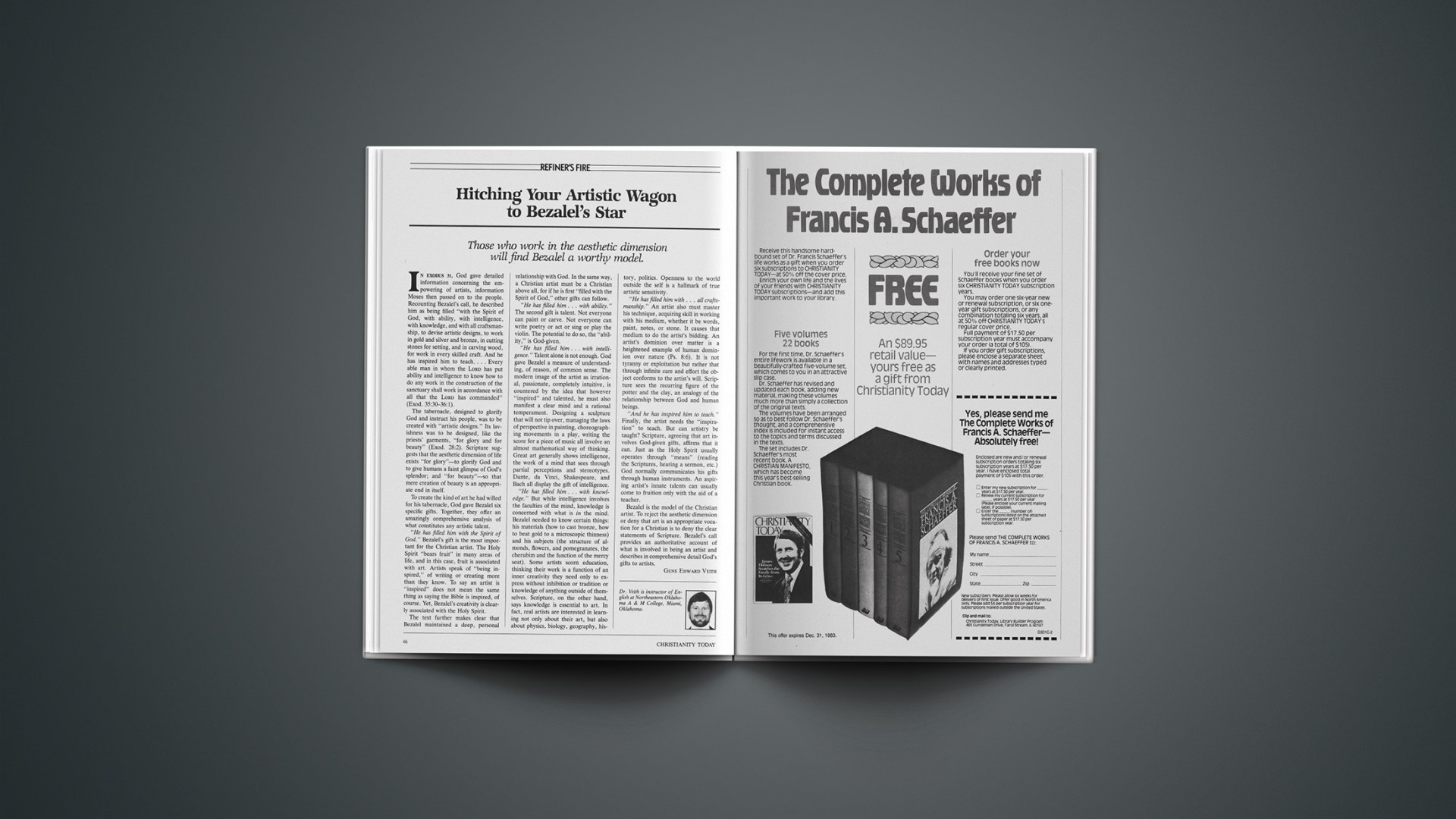Those who work in the aesthetic dimension will find Bezalel a worthy model.
In exodus 31, God gave detailed information concerning the empowering of artists, information Moses then passed on to the people. Recounting Bezalel’s call, he described him as being filled “with the Spirit of God, with ability, with intelligence, with knowledge, and with all craftsmanship, to devise artistic designs, to work in gold and silver and bronze, in cutting stones for setting, and in carving wood, for work in every skilled craft. And he has inspired him to teach.… Every able man in whom the LORD has put ability and intelligence to know how to do any work in the construction of the sanctuary shall work in accordance with all that the LORD has commanded” (Exod. 35:30–36:1).
The tabernacle, designed to glorify God and instruct his people, was to be created with “artistic designs.” Its lavishness was to be designed, like the priests’ garments, “for glory and for beauty” (Exod. 28:2). Scripture suggests that the aesthetic dimension of life exists “for glory”—to glorify God and to give humans a faint glimpse of God’s splendor; and “for beauty”—so that mere creation of beauty is an appropriate end in itself.
To create the kind of art he had willed for his tabernacle, God gave Bezalel six specific gifts. Together, they offer an amazingly comprehensive analysis of what constitutes any artistic talent.
“He has filled him with the Spirit of God.” Bezalel’s gift is the most important for the Christian artist. The Holy Spirit “bears fruit” in many areas of life, and in this case, fruit is associated with art. Artists speak of “being inspired,” of writing or creating more than they know. To say an artist is “inspired” does not mean the same thing as saying the Bible is inspired, of course. Yet, Bezalel’s creativity is clearly associated with the Holy Spirit.
The text further makes clear that Bezalel maintained a deep, personal relationship with God. In the same way, a Christian artist must be a Christian above all, for if he is first “filled with the Spirit of God,” other gifts can follow.
“He has filled him … with ability.”The second gift is talent. Not everyone can paint or carve. Not everyone can write poetry or act or sing or play the violin. The potential to do so, the “ability,” is God-given.
“He has filled him … with intelligence.” Talent alone is not enough. God gave Bezalel a measure of understanding, of reason, of common sense. The modern image of the artist as irrational, passionate, completely intuitive, is countered by the idea that however “inspired” and talented, he must also manifest a clear mind and a rational temperament. Designing a sculpture that will not tip over, managing the laws of perspective in painting, choreographing movements in a play, writing the score for a piece of music all involve an almost mathematical way of thinking. Great art generally shows intelligence, the work of a mind that sees through partial perceptions and stereotypes. Dante, da Vinci, Shakespeare, and Bach all display the gift of intelligence.
“He has filled him … with knowledge.” But while intelligence involves the faculties of the mind, knowledge is concerned with what is in the mind. Bezalel needed to know certain things: his materials (how to cast bronze, how to beat gold to a microscopic thinness) and his subjects (the structure of almonds, flowers, and pomegranates, the cherubim and the function of the mercy seat). Some artists scorn education, thinking their work is a function of an inner creativity they need only to express without inhibition or tradition or knowledge of anything outside of themselves. Scripture, on the other hand, says knowledge is essential to art. In fact, real artists are interested in learning not only about their art, but also about physics, biology, geography, history, politics. Openness to the world outside the self is a hallmark of true artistic sensitivity.
“He has filled him with … all craftsmanship.” An artist also must master his technique, acquiring skill in working with his medium, whether it be words, paint, notes, or stone. It causes that medium to do the artist’s bidding. An artist’s dominion over matter is a heightened example of human dominion over nature (Ps. 8:6). It is not tyranny or exploitation but rather that through infinite care and effort the object conforms to the artist’s will. Scripture sees the recurring figure of the potter and the clay, an analogy of the relationship between God and human beings.
“And he has inspired him to teach.” Finally, the artist needs the “inspiration” to teach. But can artistry be taught? Scripture, agreeing that art involves God-given gifts, affirms that it can. Just as the Holy Spirit usually operates through “means” (reading the Scriptures, hearing a sermon, etc.) God normally communicates his gifts through human instruments. An aspiring artist’s innate talents can usually come to fruition only with the aid of a teacher.
Bezalel is the model of the Christian artist. To reject the aesthetic dimension or deny that art is an appropriate vocation for a Christian is to deny the clear statements of Scripture. Bezalel’s call provides an authoritative account of what is involved in being an artist and describes in comprehensive detail God’s gifts to artists.
GENE EDWARD VEITH1Dr. Veith is instructor of English at Northeastern Oklahoma A & M College, Miami, Oklahoma.










